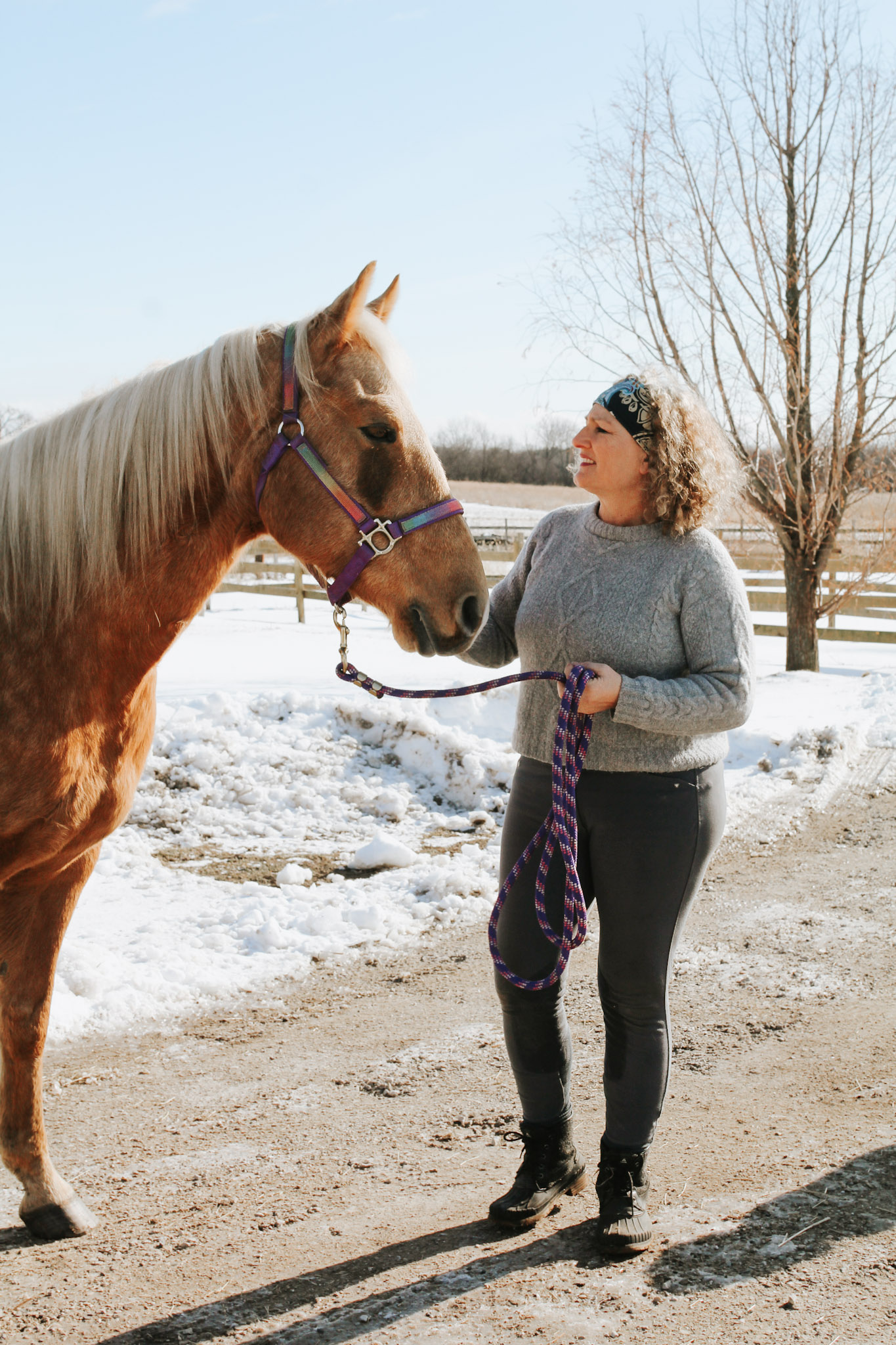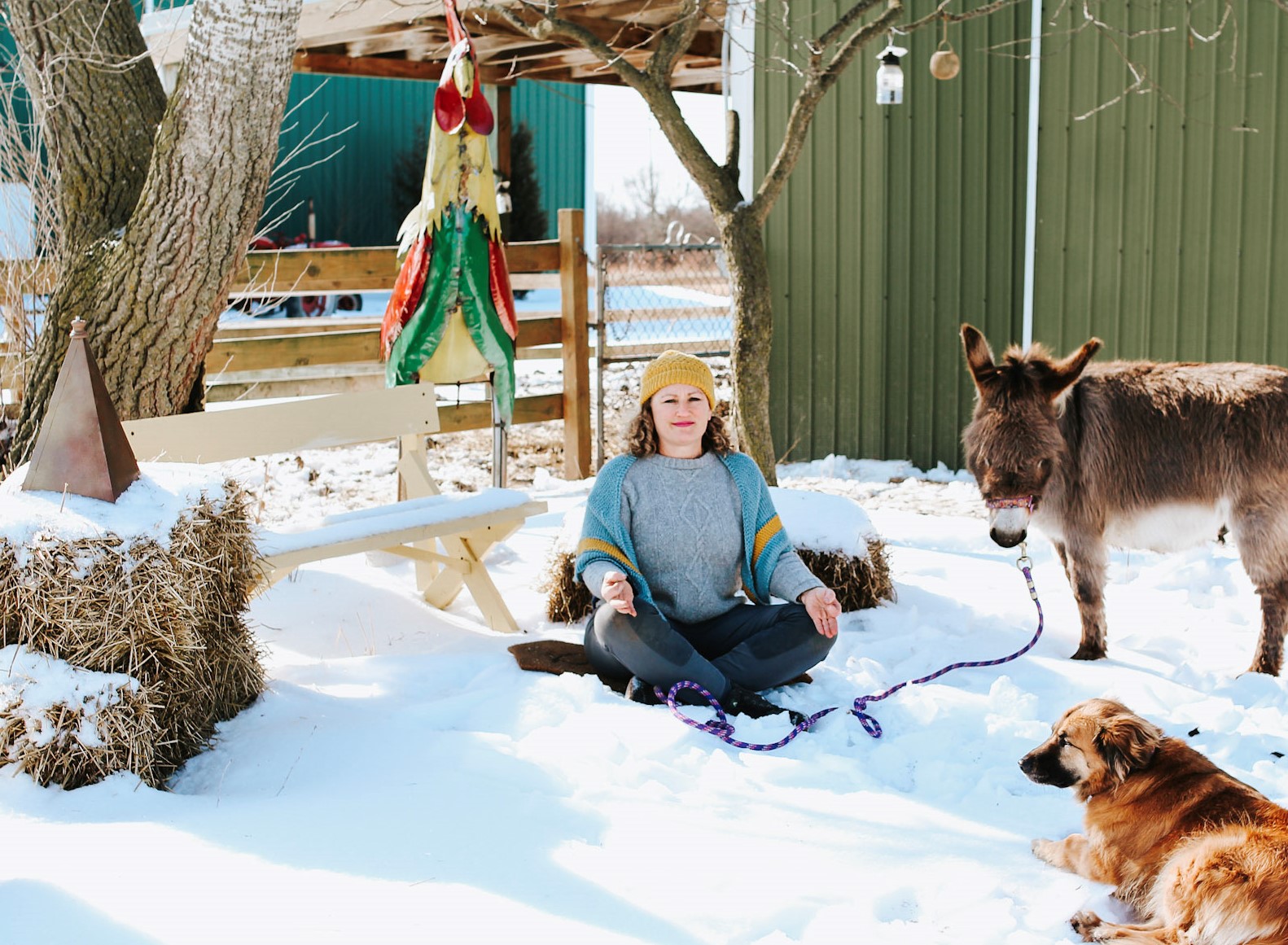I grew up riding horses. Not in the show ring or polo field or the rodeo world, just good ‘ole wind-in-your-hair, sun-on-your-face riding in the open fields around my family’s farm. I spent hours with my horse; so much so that if he laid down, I could sit next to him, and he would put his head in my lap.

Forty-some years later, I’ve come to understand how much my time with horses has helped me better cope with anxiety and the stresses of everyday life. I was once a single mom raising twins and working in a corporate and consumer-driven world. Like many people, I was “busy” for years, but when the kids were grown, my childhood interest in horses led me to add something new to my plate: volunteering for Equestrian Connections in Lake Forest, IL. My time spent leading horses for children and adults on therapy rides got me thinking about my own path.
Fast forward through midlife job shifts, the loss of both of my parents, and a challenging certification process, and I now find myself an instructor at both Equestrian Connections and Susanna Farms, my sister Elizabeth and my farm in Lake Villa, IL. Maintaining the farm, running a business and caring for the animals, means I’m still pretty “busy,” but I find I’m more grounded because of my experience as a therapeutic horseback riding teacher.
Here’s what I’ve learned (spoiler alert: many of these lessons I learned riding as a kid, but with training, teaching and “adulting” experience, I now have a deeper understanding and the language to better explain it).
Less is more – We’ve all heard this before, but, on a horse, it is so amazing to see a rider learn that the clearer, simpler and softer our communication, the faster we get a fluid and consistent response from our horse. Of course, this type of calm, clear “horse whispering” can also be applied to teaching, parenting, “spouse-ing” and relating in general.
Let it sink in—Asking and waiting for a response before assuming your equine isn’t listening is a learned skill. Even the clearest communication may not generate an instant response. Wait for it. Then, once you do get a positive or “correct” response from a horse, wait three seconds more before asking for something new.
The same applies to students, but with students, it might take more than three seconds! As a rider learns a new skill, I’ve learned to wait and really let the new skill become automatic before moving on to the next skill or task.
Outside the arena, I’ve come to discover that the same is also true. We live in a “busy” world with new requests and demands coming at us all the time. When working with humans as well as horses, I find myself more successful when I allow time in between “asks” and just let the new skill really sink in.

Don’t mix the message—“The release is the reward” is a phrase we use in the horse world a lot. Rewarding by releasing from a que as soon as the horse responds positively lets the horse know it did what you wanted. If you don’t get the response you were looking for, be sure that you gave a clear que and aren’t sending mixed messages and then ask again. For example, if I’m asking my horse to walk forward with my legs while holding on the reins, that’s not clear communication.
How often do we see this in work and family communication as well? Mixing messages, failing to give praise when praise is due, or rewarding for bad behavior are communication blunders that are as ineffective with humans as they are with horses.
Be mindful of not only what but how you communicate—What’s great about horses is that each horse has a unique personality and can be responsive to humans who are, of course, equally unique. But, because of these unique characteristics, effective communication must be individualized. It is not enough to clearly communicate. The expectations that are being communicated must be realistic for all participants, and the communication must be done in a manner that the horse (or person) with whom you are communicating is best able to understand.
It is far too easy to fall into communication patterns that are comfortable for us but may not be as effective for everyone else. As a result of my therapeutic teaching experiences, I make a greater effort to ask if what I’m saying makes sense to the individual with whom I’m working, and, based on the response, adjust. Among my students, and even between my horses, I change some of my ques to better fit what works for the individual animal or person.
In therapeutic horseback training, in order to effectively create an individualized plan that helps the rider achieve his or her goals, we need to be aware of not only the particular horse’s needs but also the unique needs of the human rider. This plan also needs to be further adapted to the special circumstances for equines and humans on any given day. As with the other lessons learned, this flexibility is critical not only to our success as teachers and riders, but also helpful in our day-to-day connection with the humans around us.

“Tied to the patience tree” – I got a new mini donkey (so adorable!) last year, and I started training him by tying him to a post and letting him just stand there. At first, he pulled and struggled a lot, but eventually, he learned to just stand there. My sister-in-law called this being “tied to the patience tree.” The first time she said it, I just loved it! I even had a mat made up for myself for meditation that says “Patience.” I sit on the mat by a tree for my own metaphoric patience training. Allowing myself to be “tied to the patience tree” is probably the most important personal lesson I’ve learned from teaching therapeutic horseback riding.
Working with horses and humans is incredibly rewarding. I’m grateful for all I’m learning and for the opportunity to continue to be able to help individuals who are working with a variety of physical and emotional issues. In the end, however, I’ve come to learn that this work is just as important and relevant for everyone, including myself. We all have “issues” and participating in equine-assisted activities is a great way to connect with oneself and with those around us in ways that improve communication, help build patience, create acceptance, and celebrate the unique space we each hold in this complicated world.


